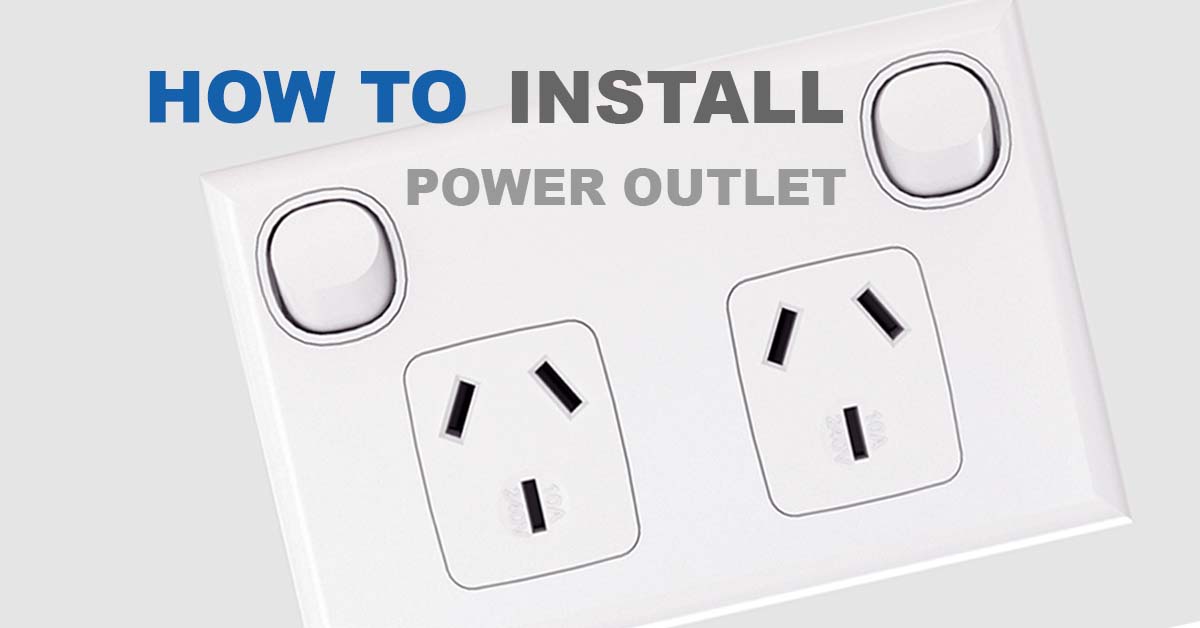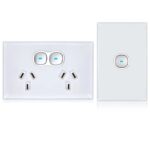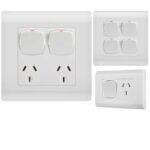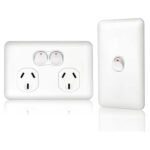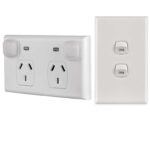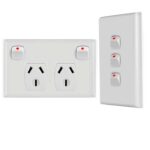Installing a new power outlet in your home is no easy feat! That’s especially true if, like most of us, you’ve never studied to be a sparky. You might be tired of using extension cords, or just looking for a different spot for your TV. Whatever the case, this explanatory guide will help you on your way! We’ll cover the basics of the types of power outlets you can buy, how much power outlets cost, and how an electrician would install them. We’ll also go through the laws surrounding electrical work in Australia.
Table of Contents
Choosing a Power Outlet
There are several different types of power outlets you can choose from. They range from the elegance of the glass and slimline outlets, to the functionality of the large dolly and weatherproof outlets.
Glass Electrical Outlet
Chic, stylish and understated, the glass electrical outlet is a designer’s dream. With push-buttons, smooth edges, and a glossy faceplate, the glass electrical outlet goes well as a finish for high-quality home renovations. Minimalism is in right now, and this option is perfect if you want to make a statement.
Large Dolly Outlet
The large dolly outlet is ideal for folks who find it hard to press smaller buttons. Designed with functionality in mind, the large dolly finds a great home in aged care facilities, retirement villages, and nursing homes, as its larger size (120mm x 120mm) makes it much easier to use.
Slimline Power Point
Most other slimline power outlets are between 4mm and 9mm thick. The Slim Wafer slimline outlets, by contrast, are just 2mm thick, providing a stylish look on any wall. What’s more, Wafer slimline range is the only retrofittable thin profile outlet on the Australian market. If you want to exchange old, outdated power points without needing paper templates or expensive mounting plates, this is your best bet!
Weatherproof Power Point
Connecting electricity to your outdoors is a must. Fixed settings such as outdoor lighting and speaker systems demand available electrical sockets year-round, and a huge number of chores in your backyard will require electricity too: think pressure cleaners, leaf blowers, and lawnmowers, to name a few. For outdoor power, the weatherproof power points are a great choice. Take a look at Neptune Weatherproof IP65 if you’re interested.
Classic Powerclip Outlet
Transco offers a range of classic powerclip outlets including those with one, two, and four outlets. Whether you’re looking for white, black, single pole or double pole, Transco Electrical has you covered.
Installing a Power Outlet
Now for what you’ve been waiting for: how to install an electrical power outlet. However, before we get started, a warning: rewiring a power point is illegal in Australia if you are not a licensed professional. This guide will show you the steps involved, but performing this yourself can incur hefty fines if you haven’t had the appropriate training!
Our advice: call an electrician.
There’s a couple of ways to install a power outlet: you can either replace an existing wall power outlet with a new one, or you can add a new outlet nearby an existing one.
Replacing a Power Outlet
If you’re looking to replace a power outlet, the process is fairly straightforward. All you’ll need are wire strippers, a screwdriver, and the new outlet.
- As with any electrical work, the first thing you need to do is turn off the power supply at your property’s main switch. If you want to be extra sure that the power is off, you can use a voltage tester.
- Remove the faceplate of the existing power outlet, before unscrewing and pulling out the outlet itself.
- Remove the wires from the old outlet, then attach the new outlet by connecting
- the Brown (or Red) wire to the Active (A) terminal screw,
- the Blue (or Black) wire to the Neutral (N) terminal screw, and
- the Green/Yellow wire to the Earth (E) terminal screw.
- Push the outlet back into the wall, screw in the new outlet and faceplate, and you’re good as gold.
Adding a New Power Outlet
The same general process applies if you’re looking to add a new outlet nearby an existing one, but with a few added steps. In this case, you’ll also need a drill, a drywall saw, a length of 2.5mm2 TPS electrical cable, an electronic stud finder, and a pencil.
- First, as before, turn off the power at the main switch.
- Second, you’ll have to identify a spot that’s close or adjacent to an existing electrical outlet; perhaps the other side of a wall. You can locate existing studs (studs are the wooden boards in the walls that support electrical wiring) using an electronic stud finder. Trace the shape of your new outlet onto the wall in between two existing studs, then cut out that shape using a drywall saw.
- Third, unscrew and take out the existing electrical outlet you identified earlier. Cut enough sheathing of the new 2.5mm2 TPS cable, strip the insulation and twist the copper before attaching wires to the existing outlet as such:
- the Brown (or Red) wire to the Active (A) terminal screw,
- the Blue (or Black) wire to the Neutral (N) terminal screw, and
- the Green/Yellow wire to the Earth (E) terminal screw.
- Next, pull the new cord out through the other side of the wall where you’ve made your new hole. Connect the wires the same way to your new outlet: Brown (or Red) to Active, Blue (or Black) to Neutral, and Green/Yellow to Earth.
- Finally, secure the new, wired outlet into the wall, and attach the new faceplate. After the power is turned back on you’ll be good to go!
How much does it cost to add a power outlet?
Some electricians charge by the hour and some by the job. Most sparkies will charge a call-out fee of up to $100, plus hourly rates of between $60 and $100. Changing an electrical power outlet is, by-and-large, pretty easy work, so it shouldn’t take your electrician too long to complete. A ball-park estimate would be around 20 minutes, depending on the type of outlet you’re looking to install and your existing connection to power.
Summing up, it should cost around $150 to change a power outlet or up to $200 for multiple outlets.
Buy a power outlet from Transco today
Whether you’re looking to use an electrician or your own electrical qualifications to install a power outlet, Transco Electrical has you covered. Shop for high-quality glass, large dolly, slimline, weatherproof, and classic powerclip electrical outlets at affordable prices, and install your new power outlet today!
And just to reiterate what was said before, rewiring a power point is illegal in Australia if you are not a licensed professional so this article is for you to understand the job at hand but not to do it yourself!
